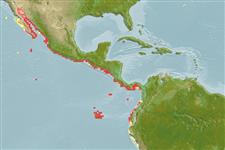>
Acanthuriformes (Surgeonfishes) >
Chaetodontidae (Butterflyfishes)
Etymology: Johnrandallia: After John Randall, marine biologist, Bishop Museum of Hawaii; he worked in systematic ichthyology with fishes of Indopacific region.
More on author: Gill.
Environment: milieu / climate zone / depth range / distribution range
Ecologia
marinhas associadas(os) a recifes; intervalo de profundidade 6 - 40 m (Ref. 9286), usually 6 - 12 m (Ref. 9286). Tropical; 40°N - 10°S, 120°W - 70°W
Eastern Pacific: Gulf of California to Panama, including the Cocos, Malpelo and Galapagos Islands.
Tamanho / Peso / Idade
Maturity: Lm ? range ? - ? cm
Max length : 20.0 cm TL macho/indeterminado; (Ref. 9286); common length : 14.0 cm TL macho/indeterminado; (Ref. 55763)
Descrição suscinta
Chaves de identificação | Morfologia | Morfometria
Espinhos dorsais (total) : 11 - 12; Raios dorsais (total) : 24 - 25; Espinhos anais: 3; Raios anais : 18 - 20. Body deep, compressed, and disk-shaped; dorsal profile of head steep and concave; snout pronounced; teeth very small and se in a comb-like band; base of pelvic spine with an axillary process; lateral line complete, extending over caudal peduncle; body yellowish; snout with a dark stain; eye bordered with black; posterior edge of operculum, base of pectoral fins, nape, and dorsal border (at base of dorsal fin) black (Ref. 55763).
Often in large schools (Ref. 5227) over coral and rocky reefs (Ref. 9286). Feed on algae, gastropods, and small crustaceans (Ref. 9286). Pick parasites from larger fishes like Paranthias colonus and Mulloides dentatus (Ref. 28023). Oviparous (Ref. 205). Form pairs during breeding (Ref. 205).
Ciclo de vida ou comportamento de acasalamento
Maturities | Reprodução | Spawnings | Egg(s) | Fecundities | Larvas
Form pairs during breeding (Ref. 205).
Schneider, M., 1995. Chaetodontidae. Peces mariposa. p. 1000-1003. In W. Fischer, F. Krupp, W. Schneider, C. Sommer, K.E. Carpenter and V. Niem (eds.) Guia FAO para Identification de Especies para lo Fines de la Pesca. Pacifico Centro-Oriental. 3 Vols. FAO, Rome. (Ref. 9286)
Status na Lista Vermelha da UICN (Ref. 130435)
Ameaça para os humanos
Harmless
Uso pelos humanos
Pescarias: espécies comerciais; Aquário: Espécies comerciais
Ferramentas
Relatórios especiais
Baixar XML
Fontes da internet
Estimates based on models
Preferred temperature (Ref.
123201): 17.9 - 29, mean 26.6 °C (based on 144 cells).
Índice de diversidade filogenética (Ref.
82804): PD
50 = 1.0000 [Uniqueness, from 0.5 = low to 2.0 = high].
Bayesian length-weight: a=0.02818 (0.01685 - 0.04715), b=3.08 (2.94 - 3.22), in cm total length, based on LWR estimates for this species & (Sub)family-body (Ref.
93245).
Nível Trófico (Ref.
69278): 3.0 ±0.44 se; based on food items.
Resiliência (Ref.
120179): Elevada, tempo mínimo de duplicação da população menor que 15 meses (Preliminary K or Fecundity.).
Fishing Vulnerability (Ref.
59153): Low vulnerability (10 of 100).
Nutrients (Ref.
124155): Calcium = 89.4 [47.0, 136.0] mg/100g; Iron = 0.773 [0.468, 1.239] mg/100g; Protein = 18.6 [17.4, 19.6] %; Omega3 = 0.114 [0.071, 0.177] g/100g; Selenium = 34.1 [19.7, 61.6] μg/100g; VitaminA = 46.2 [13.5, 153.7] μg/100g; Zinc = 1.4 [1.0, 2.0] mg/100g (wet weight);
